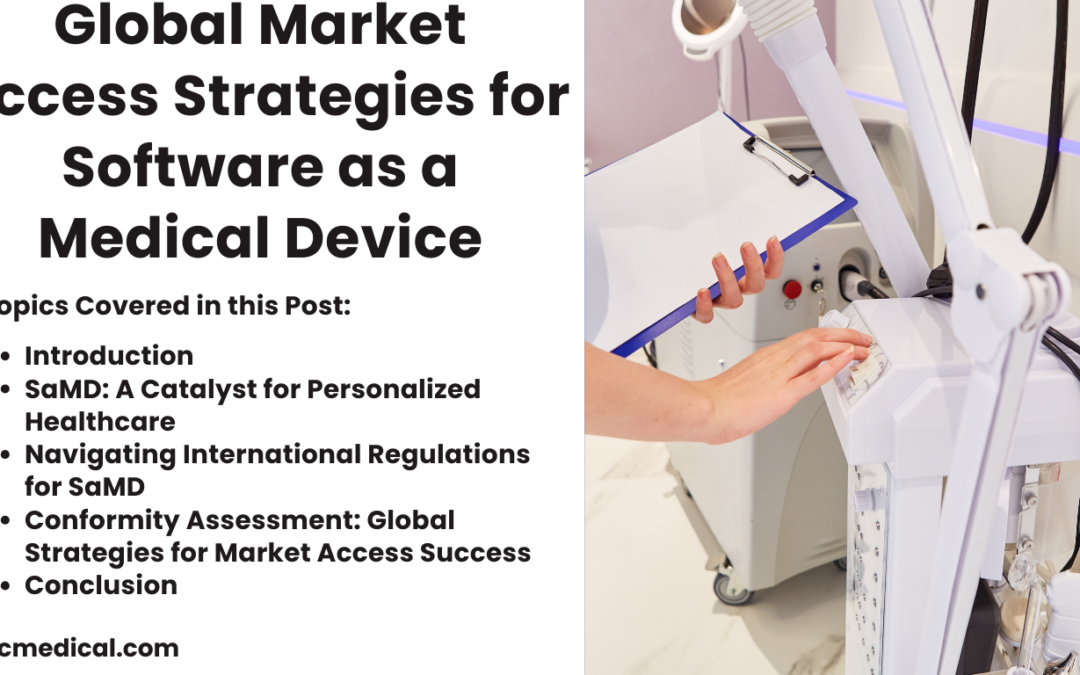Introduction
In the ever-evolving realm of healthcare technology, Software as a Medical Device (SaMD) stands out as a transformative force, offering personalized solutions tailored to individual patient needs.
As demand surges for SaMD solutions worldwide, understanding and navigating international regulations are paramount for market access success.
This article explores global strategies for achieving market access for SaMD, delving into the intricacies of international regulations and conformity assessments.
SaMD: A Catalyst for Personalized Healthcare
SaMD has revolutionized healthcare delivery by providing customized solutions that align with patients’ unique requirements. From diagnostic tools to treatment planning software, SaMD empowers clinicians and patients with personalized insights, enhancing patient care and operational efficiency.
As the demand for tailored healthcare solutions grows, the global SaMD market presents lucrative opportunities for manufacturers. However, accessing these markets requires a comprehensive understanding of international regulatory frameworks.
Navigating International Regulations for SaMD
Achieving market access for SaMD hinges on compliance with international medical device regulations. In the United States, the Food and Drug Administration (FDA) regulates SaMD through stringent premarket clearance or approval processes.
Similarly, in Europe, the European Medical Device Regulation (MDR) categorizes medical devices based on risk levels, with SaMD falling under Class I to Class III classifications.
Understanding the nuances of global regulations is essential for manufacturers seeking to enter international markets. Harmonizing regulatory strategies across regions streamlines the market access process and ensures compliance with diverse regulatory requirements.
Conformity Assessment: Global Strategies for Market Access Success
Conducting a thorough conformity assessment is imperative for SaMD manufacturers aiming to penetrate international markets. This assessment evaluates the product’s conformity with regulatory standards and determines its eligibility for market entry.
Key components of a successful conformity assessment include:
1. Regulatory Compliance Review
Conduct a comprehensive review of international regulations applicable to SaMD, including FDA guidelines in the US and MDR requirements in Europe.
2. Risk Management Analysis
Identify and mitigate potential risks associated with SaMD, ensuring compliance with risk management standards such as ISO 14971.
3. Design Controls Implementation
Establish robust design controls to document the software development process and ensure adherence to regulatory requirements.
4. Clinical Evaluation and Usability Studies
Perform clinical evaluations and usability studies to validate the safety, effectiveness, and clinical validity of SaMD.
5. Quality Management System Implementation
Implement a quality management system compliant with ISO 13485 standards to maintain product quality and regulatory compliance.
6. Cybersecurity Measures
Implement robust cybersecurity measures to safeguard patient data and comply with international cybersecurity regulations.
7. Premarket Clearance or Approval
Prepare and submit premarket clearance or approval applications to regulatory authorities, demonstrating SaMD’s safety and efficacy for its intended use.
8. Post-Market Surveillance Plan
Develop a post-market surveillance plan to monitor SaMD performance and address any post-market issues or concerns.
By prioritizing conformity assessment and regulatory compliance, SaMD manufacturers can navigate international regulations effectively and access global markets with confidence.
Conclusion
As the demand for personalized healthcare solutions continues to rise, Software as a Medical Device (SaMD) holds immense potential for transforming patient care worldwide. However, accessing international markets requires a thorough understanding of global regulations and a strategic approach to conformity assessment.
By navigating international regulations adeptly and prioritizing regulatory compliance, SaMD manufacturers can unlock opportunities for market expansion and contribute to advancing global healthcare delivery.
